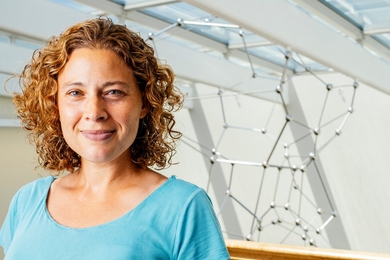In the spring of 2013, Kirin Sinha '14 started SHINE for Girls with the objective to improve math skills and confidence of local middle school girls.
Now, with additional locations in California, Florida, Virginia, and Washington, the original Boston branch is run by MIT student mentors and includes learning through small group study sessions of tutoring. However, what sets this group apart is the primary method teaching: Shine harnesses kinesthetic learning principles by combining math and dance.
SHINE addresses the stigma that being good at math is not considered cool. MIT junior Emily Benz related her own experience of hearing her name announced for a math award over the public address system at her middle school. “I wanted to cry in shame. I was so afraid,” she said. Benz knows she was fortunate enough to gain confidence in her abilities, eventually going on to join her high school math team and end up at MIT studying electrical engineering and computer science, but feels her good fortune to be an anomaly among girls.
Once at MIT, Benz picked up dancing despite having little experience. “I gained a lot of self-confidence going on stage and performing in front of my peers and putting it all out there,” Benz says. She is now channeling these personal experiences with math and dance to positively impact other girls as a SHINE mentor.
Interestingly, Benz says she still remembers dance moves from her performances distinctly, but not specifics from 18.01 (Single Variable Calculus), even though she was engaged in that class. This sentiment gets at the heart of the methods of SHINE: using dance to make math stick.
Kinesthetic learning activities tackle topics such as fractions, geometry, probability, graphing, and pre-algebra. For example, the exercise “choreographing algebra” helps conceptualize the idea of a variable. Benz described that the girls may be instructed to do two ball changes, a spin, and then do two more ball changes. This combination is equivalent to four ball changes and one spin, and if the ball changes represent “x” and the spin is “y” this dance combination created 4x+y. The ball changes can be grouped together while the spin cannot because a spin is not the same as a ball change, just as different variables do not represent the same thing.
Research has found that when boys and girls are presented with an unfamiliar task, girls are more likely to respond, “I can’t” while their male counterparts say, “I don’t know” or “I will try.” Shine purposefully gives its participants difficult questions to teach that it is okay to try and fail. Participants take a pretest at the beginning of the program in which they spend about 10 minutes and usually only get one or two correct answers. Mentors administer a final test at the conclusion of the program. With SHINE’s education, the girls get more correct answers, but most importantly they spend a full hour working through the problems. It is a metric of SHINE’s goal to instill the confidence to attempt a new task combined with the grit to work through a challenge regardless of the outcome.
“It has been rewarding as a mentor to be connected to a girl and watch her grow over time,” Benz says. Specifically, she illustrates the transformation of one girl whose shyness was complicated by a language barrier: “She was smart but afraid,” Benz says. At the end of the course this same girl was eagerly raising her hand and asking to approach the board to demonstrate how to do a problem to her peers. She improved her math skills while increasing her confidence to turn the “I can’t” into “I can.”
To get involved, start a new branch, or learn more, visit the SHINE for Girls website.











